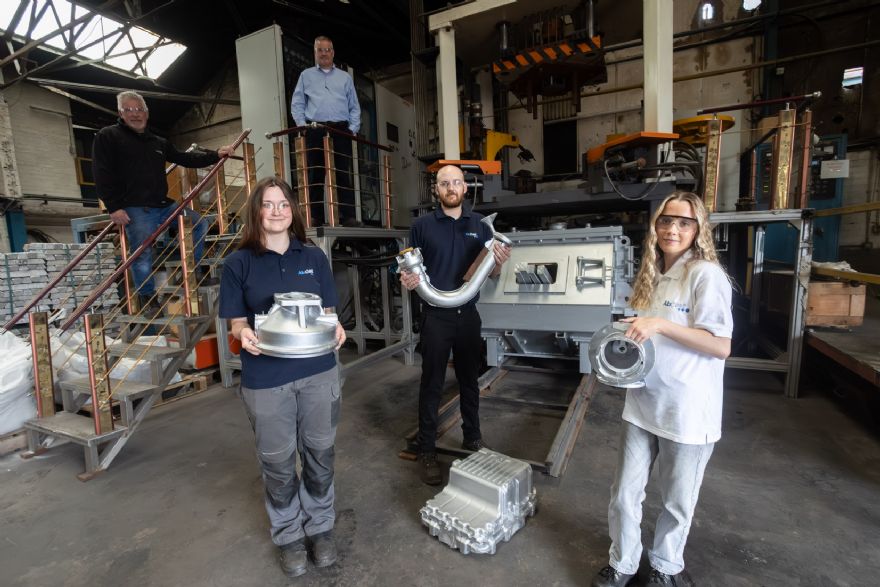 Left to right: Alucast’s foundry manager Andy Callaghan, apprentice engineer Jessica Stote, managing director Martin Haynes, foundry engineer Liam Greaves and apprentice engineer Charlie Thomas in front of the low pressure furnace
Left to right: Alucast’s foundry manager Andy Callaghan, apprentice engineer Jessica Stote, managing director Martin Haynes, foundry engineer Liam Greaves and apprentice engineer Charlie Thomas in front of the low pressure furnaceA £1 million investment in new machinery and R&D development work on a new material is set to give
Alucast Ltd a lightweighting advantage in the rail, aerospace and defence sectors. The Black Country foundry, which employs over 100 people at its factory in Wednesbury, is targeting a multi-million-pound opportunity in low-pressure die casting with customers looking to tap into this form of casting to take weight out of parts and achieve high integrity, high-strength, components.
An HDTD low-pressure die-casting machine is the latest addition to the firm’s dedicated cell and can produce larger parts more quickly, while it has wasted no time bringing a new alloy to market for Very Light Rail (VLR) and other industrial sectors. Tapping into a £50,000 grant, Alucast was set the challenge to come up with a lighter alternative to SG Iron 420:10, which is commonly used in the construction of carriages.
Engineers at the company met this task head on, building on the success of ALU-HPI in its sand-casting process to advance it for use in low-pressure casting. By optimising metal flow and refining heat treatment, the foundry was able to come up with an alloy that was one third of the weight of SG Iron and yet still achieves key targets for proof stress, ultimate tensile strength (UTS) and elongation.
Alucast’s chairman Tony Sartorius said: “We have already created sand-cast parts using this alloy for military vehicles and knew there was the opportunity to adapt it to low-pressure. This could be a massive gamechanger for every sector that is looking to secure weight savings without risking performance. Our metallurgists have already achieved UTS targets of 420 MPa and further heat treatment modifications will allow us to achieve the 10% elongation goal.”
New solution for lighter partsHe continued: “The combination of our dedicated low-pressure casting facility and the new ALU-HP1 material means we are now in a perfect place to offer a new solution for clients looking for lighter parts in aerospace, rail and, with an increase in Government spending, defence. There is no reason why we can’t secure more than £1.5 million of new work over the next 12 months and this will certainly help create jobs.”
Alucast has built up an enviable track-record for its low-pressure casting expertise, a technique that offers improved metal quality and component strength, due to the low-pressure process reducing porosity, turbulence and oxidation.
John Swift, CEO of Alucast’s CEO, said: “In essence, the metallurgical advantages of low-pressure die casting stems from its ability to control the filling process, reduce oxidation, minimise porosity, and promote uniform solidification, resulting in higher-quality, high integrity castings. These attributes are extremely important when casting the ALU-HP1 alloy as porosity and oxides must be eliminated to achieve the high UTS and elongation figures achieved with this alloy.”
He concluded: “There is a real opportunity for the UK to lead the way when it comes to lightweighting and we are keen to bring as much manufacturing back home as possible and boost the GDP of the nation.”
Alucast is unique in the UK in that it has the four main casting processes on one site - sand, gravity, high-pressure and low-pressure casting.